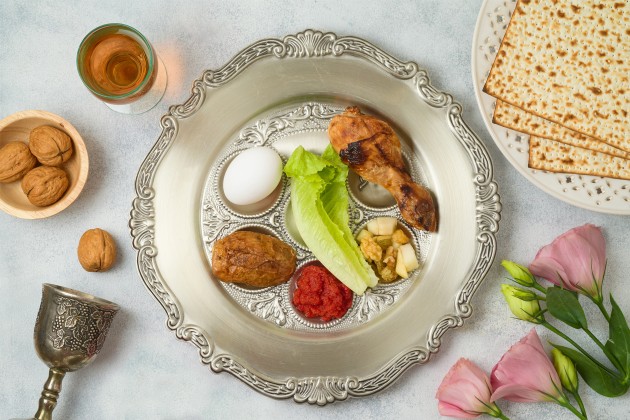How Do You Celebrate: Passover

It all started with a bag of plagues.
Yes, you read that correctly. I found this curious holiday accessory one spring while shopping for Passover staples at our local grocery store. My daughters were 5 and 2, and I was hoping to interest them in a holiday that isn’t typically listed among a kid’s favorites.
The bag contained some obvious representations of the biblical plagues — a small plastic frog, a rubber locust — and some more creative ones, like a pair of sunglasses to represent darkness. I brought the plagues home with the matzo.
But this impulse buy, which did engage my daughters in our Seder, wasn’t my only unconventional attempt at celebrating the holiday.
One of my daughters acted out the story of Passover at her preschool, and the teachers made each family a book of the children’s photos and quotes. (“There were slaves. They worked a week, a month … maybe 10 years.” “There was a big sister named Addison. I mean Miriam.”) My husband and I read this entertaining, if not entirely accurate, version of the Passover story at our Seder table for years to come. As our daughters got older, we graduated to a kid-friendly “Haggadah” text, and I continued looking for ways to get them involved, on their level, in our annual telling of the Passover story.
As it turns out, the practice of creative storytelling when we acknowledge the Israelites’ liberation from slavery in Egypt is nothing new.
The traditional search for the missing Afikoman, or “dessert matzo,” for example, “has nothing to do with the story of Passover,” notes Rabbi Avi Friedman of Congregation Ohr Shalom/The Summit Jewish Community Center in Summit, New Jersey. “It was added by the rabbis over a millennium after the story of Passover is estimated to have taken place. Why was it added? To provide entertainment for kids and to keep them engaged. Those rabbis set an important precedent. The whole point of the Passover Seder is to fulfill the biblical obligation to ‘tell your children’ about the Exodus from Egypt. …
“My advice to parents is to creatively tell the story of the Exodus in a way that their children will hear it and understand it. After all, that's the ultimate goal. Otherwise, we're just reading words off a page — and we don't need a Seder in order to do that,” Rabbi Friedman explains.
Rabbi Friedman adds that a sign of the times may also show up at your table. “We have added four squirts of Purell alongside the four cups of wine and the four questions,” he says of his own Seder. “How can we tell the story of ancient plagues while completely ignoring a modern one?”
Rabbi Menachem Linzer, principal of the modern orthodox Hillel Torah North Suburban Day School in Skokie, Illinois, agrees with taking a creative approach to Passover with children. “Not only is there nothing wrong with adding playful elements to the Seder, but playful, fun, and engaging ‘shtick’ (Yiddish for silly gimmicks) are actually essential to accomplishing the goal of the Seder itself, to ‘see one’s self as if one left Egypt,’” says Rabbi Linzer. “The only way to do this is to get into character, connect with the story, and make it relevant to one’s life today. Since each child learns and connects differently, one needs to employ a variety of tactics and techniques to activate the imagination and curiosity of each person at the Seder.”
And while telling the story of Passover is a major significant part of the celebration, many Jews strongly associate Passover with something else: the food. (One of my own prevailing childhood memories is the chopped liver my family snacked on before the meal!) Both rabbis agreed on the significance of what families eat as part of the holiday.
“In some ways, the traditional aspects of the holiday are the most important and have an even deeper impact on our children,” says Rabbi Linzer. “Grandma’s recipes, the smells in the house on the afternoon before the Seder, not being able to tolerate the horseradish being ground — these are the deeper memories and sensations that help children feel a special connection to their families and, by extension, to Jewish tradition as a whole, becoming the next link in the chain.”









